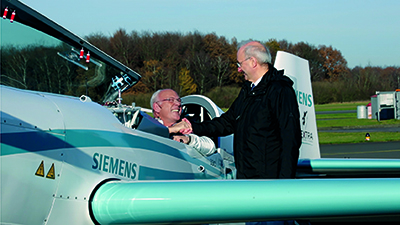- Extra 330LE electric plane sets world record
- New climb performance record: altitude of 3,000 meters in just 4 min 22 sec
- World air sports federation FAI confirms world record
On Friday, November 25, 2016, the Extra 330LE aerobatic aircraft powered by a drive system from Siemens set a new world record for time to climb. At the Dinslaken Schwarze Heide airfield in Germany, the electric-powered plane reached an altitude of 3,000 meters in just four minutes and 22 seconds – a climb velocity of 11.5 meters per second. The time set by pilot Walter Extra was 1 minute 10 seconds faster than the previous world record set by U.S. pilot William M. Yates in 2013. The world air sports federation, Fédération Aéronautique Internationale (FAI), has officially recognized the record flight in the category “Electric-powered planes less than 1,000 kilograms.”
The new drive system from Siemens completed its first flight only in June 2016. The handy electric aircraft motor was already a world-record-holder for power-to-weight ratio even then. Weighing just 50 kilograms, it supplies a constant electric output of around 260 kilowatts, or five times as much as comparable drives.
“This is another milestone on the path to the electrification of air travel,” says Frank Anton, head of eAircraft in Siemens’ venturing unit next47. “This amazing performance was possible only with digital technologies, which enabled us to optimize our drive train to its technical limit.” The Extra 330LE, weighing around 1,000 kilograms, is the trial unit for the new drive – as an aerobatic plane it’s perfectly suited to taking the components to their limits, and testing and refining them. Following an agreement in April 2016, Siemens and Airbus are cooperating to apply this technology to electric-powered flight. Electric drives are scalable, and Siemens and Airbus intend to develop hybrid electric regional aircraft based on the record-breaking motor. “By 2030, we expect to see the first electric-powered planes carrying up to 100 passengers with a range of around 1,000 kilometers,” says Anton. Siemens is determined to establish hybrid-electric propulsion systems for aircraft as a future area of business.
























